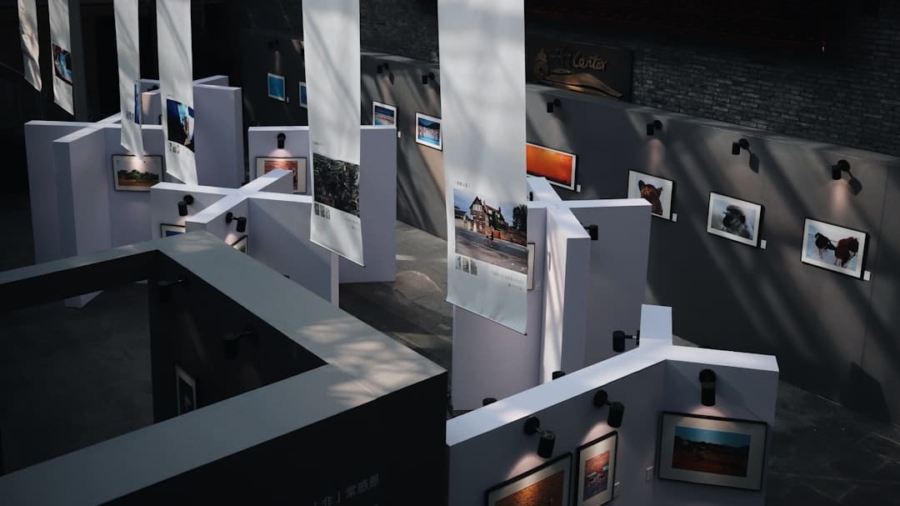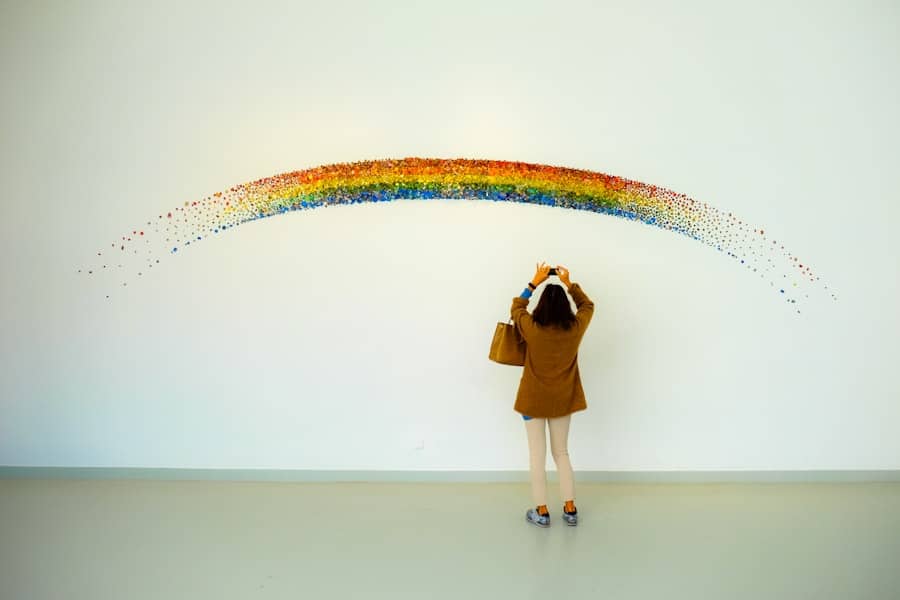Augmented Reality (AR) has emerged as a transformative force within the art world, reshaping how artists create, exhibit, and engage with their audiences. By overlaying digital information onto the physical environment, AR allows for a unique interplay between the tangible and the virtual, creating immersive experiences that were previously unimaginable. This technology has not only opened new avenues for artistic expression but has also redefined the relationship between art and its viewers.
As artists and institutions increasingly adopt AR, the boundaries of traditional art forms are being pushed, leading to innovative practices that challenge conventional notions of what art can be.
From interactive installations to mobile applications that enhance gallery visits, AR is facilitating a more dynamic engagement with art.
This technology enables artists to layer additional narratives, context, and interactivity onto their works, inviting viewers to explore deeper meanings and connections. As we delve into the various dimensions of AR’s impact on the art world, it becomes evident that this technology is not just enhancing the viewing experience but is also fostering new forms of creativity and collaboration among artists.
Key Takeaways
- AR (Augmented Reality) is revolutionizing the art world by merging digital technology with traditional art forms.
- AR is transforming traditional art exhibits by adding interactive and immersive elements, attracting new audiences and enhancing the overall experience.
- AR is enhancing the viewer experience by providing deeper insights into artworks, allowing for interactive engagement, and creating a more personalized and memorable visit.
- AR is playing a crucial role in preserving and sharing artistic legacies by digitizing and archiving artworks, making them accessible to a wider audience, and ensuring their longevity.
- AR is serving as a tool for collaborative artistic expression, allowing artists to create interactive and multidimensional artworks in partnership with technology experts and other artists.
The Impact of AR on Traditional Art Exhibits
Bridging the Gap
Such applications of AR in traditional settings demonstrate how technology can bridge the gap between historical art forms and contemporary audience expectations, creating a more engaging and informative experience.
How AR is Enhancing the Viewer Experience
AR technology is revolutionizing the viewer experience by transforming passive observation into active participation. In traditional art viewing, audiences often engage with artworks in a one-dimensional manner, simply looking at them without any interactive elements. However, AR invites viewers to become co-creators in their experience of art.
For example, an AR application might allow users to change colors or patterns within a digital overlay on a physical painting, enabling them to visualize how different artistic choices could alter the work’s impact. Moreover, AR can facilitate personalized experiences tailored to individual preferences. By utilizing data analytics and user interactions, AR applications can curate content that resonates with specific viewers.
This level of customization not only enhances engagement but also fosters a deeper emotional connection between the viewer and the artwork. For instance, an AR experience might guide users through a narrative journey based on their interests or previous interactions with art, making each visit unique and memorable.
The Role of AR in Preserving and Sharing Artistic Legacies
As the art world grapples with issues of preservation and accessibility, AR emerges as a powerful tool for safeguarding artistic legacies. Traditional methods of preserving art often involve physical conservation techniques that can be costly and time-consuming. In contrast, AR offers a digital alternative that can capture and replicate artworks in their original form while providing additional layers of information.
This capability is particularly valuable for artworks that are fragile or at risk of deterioration. Furthermore, AR facilitates broader access to art by transcending geographical barriers. Through virtual exhibitions and mobile applications, audiences worldwide can engage with artworks that they may never have the opportunity to see in person.
For example, institutions like The British Museum have developed AR experiences that allow users to explore artifacts from their collections remotely. This democratization of access not only preserves artistic legacies but also fosters a global appreciation for diverse cultures and histories.
AR as a Tool for Collaborative Artistic Expression
The collaborative potential of AR is another exciting dimension that is reshaping artistic expression. Artists from various disciplines can come together to create multi-layered works that blend different mediums and perspectives. For instance, a visual artist might collaborate with a musician to create an AR installation where viewers can experience both visual and auditory elements simultaneously.
This fusion of disciplines encourages experimentation and innovation, leading to new forms of artistic expression that challenge traditional boundaries.
This participatory approach not only enriches the artwork but also fosters a sense of ownership among viewers.
An example of this can be seen in projects like “The Night Cafe,” an immersive VR experience inspired by Vincent van Gogh’s painting of the same name. Users can explore the virtual space while also leaving their own digital marks or interpretations within it, creating a collaborative environment that blurs the lines between artist and audience.
Challenges and Opportunities for Artists Embracing AR
While the integration of AR into artistic practice presents numerous opportunities, it also comes with its own set of challenges. One significant hurdle is the technological barrier; not all artists have access to the necessary tools or expertise to create AR experiences. This disparity can lead to a divide between those who can leverage this technology effectively and those who cannot, potentially limiting diversity in artistic expression within this medium.
Additionally, there are concerns regarding the sustainability of AR projects. The rapid pace of technological advancement means that platforms and applications can quickly become obsolete, leaving artists who invest time and resources into creating AR experiences at risk of losing their work or audience engagement. However, these challenges also present opportunities for innovation and collaboration within the art community.
Artists can work together with technologists and developers to create accessible tools that democratize AR creation, ensuring that a wider range of voices can participate in this evolving landscape.
The Future of AR in the Art World
Looking ahead, the future of AR in the art world appears promising yet complex. As technology continues to evolve, we can expect even more sophisticated applications that enhance interactivity and immersion in artistic experiences. The rise of artificial intelligence (AI) alongside AR could lead to personalized art experiences that adapt in real-time based on viewer interactions or preferences.
This convergence could redefine how we understand authorship and creativity in art. Moreover, as environmental concerns grow more pressing, artists may increasingly turn to AR as a sustainable alternative to traditional materials and practices. By creating digital installations that require no physical resources, artists can reduce their ecological footprint while still engaging audiences in meaningful ways.
The potential for AR to facilitate remote collaboration among artists across different regions also opens up new avenues for cross-cultural exchange and dialogue.
Examples of Successful AR-Enabled Art Exhibits
Several successful examples illustrate how AR has been effectively integrated into art exhibits, showcasing its potential to enhance viewer engagement and artistic expression. One prominent case is “The Museum of Other Realities,” an immersive virtual reality platform that allows artists to create and showcase their work in a fully interactive environment. Visitors can explore various virtual galleries featuring works from contemporary artists while interacting with digital installations that respond to their movements.
Another notable example is “Artivive,” an app that enables artists to create augmented reality experiences linked to their physical artworks. Artists like Kira Bursky have utilized this platform to bring static paintings to life through animations that reveal hidden narratives or additional layers of meaning when viewed through a smartphone camera. Such projects exemplify how AR can transform traditional art forms into dynamic experiences that resonate with contemporary audiences.
In conclusion, as we continue to explore the intersection of technology and creativity within the art world, it becomes clear that augmented reality is not just a passing trend but a fundamental shift in how we create, share, and experience art. The ongoing dialogue between artists, technologists, and audiences will undoubtedly shape the future landscape of artistic expression in ways we are only beginning to understand.
AR technology is revolutionizing the way artists create immersive digital exhibits, allowing them to bring their visions to life in new and exciting ways. One related article that explores the intersection of technology and creativity is Ideas R Us: Software Free Studio3 to SVG Converter. This article delves into how software tools can enhance the creative process for artists, providing them with new ways to express themselves and reach audiences in innovative ways. By leveraging the latest software tools, artists can push the boundaries of their craft and create truly unique and engaging experiences for viewers.
FAQs
What is AR?
AR stands for Augmented Reality, which is a technology that superimposes digital information such as images, videos, or 3D models onto the real world, typically viewed through a smartphone or a special headset.
How is AR enabling artists to create immersive digital exhibits?
AR allows artists to create digital exhibits that can be experienced in the physical world through the use of a smartphone or AR glasses. This technology enables artists to overlay digital artwork, animations, and interactive elements onto the physical environment, creating immersive and interactive experiences for viewers.
What are some examples of AR-enabled digital exhibits created by artists?
Some examples of AR-enabled digital exhibits created by artists include virtual art installations that can be experienced in specific locations, interactive AR sculptures that respond to viewer movements, and AR-enhanced museum exhibits that provide additional information and interactive elements.
How does AR technology enhance the viewer’s experience of art?
AR technology enhances the viewer’s experience of art by allowing them to interact with digital elements overlaid onto the physical environment. Viewers can explore virtual art installations, interact with AR sculptures, and access additional information and multimedia content related to the artwork, creating a more immersive and engaging experience.
What are the benefits of using AR for creating digital exhibits?
Some benefits of using AR for creating digital exhibits include the ability to reach a wider audience by making art accessible through smartphones, the potential for creating interactive and immersive experiences, and the flexibility to create temporary or location-specific exhibits without the need for physical installations.



